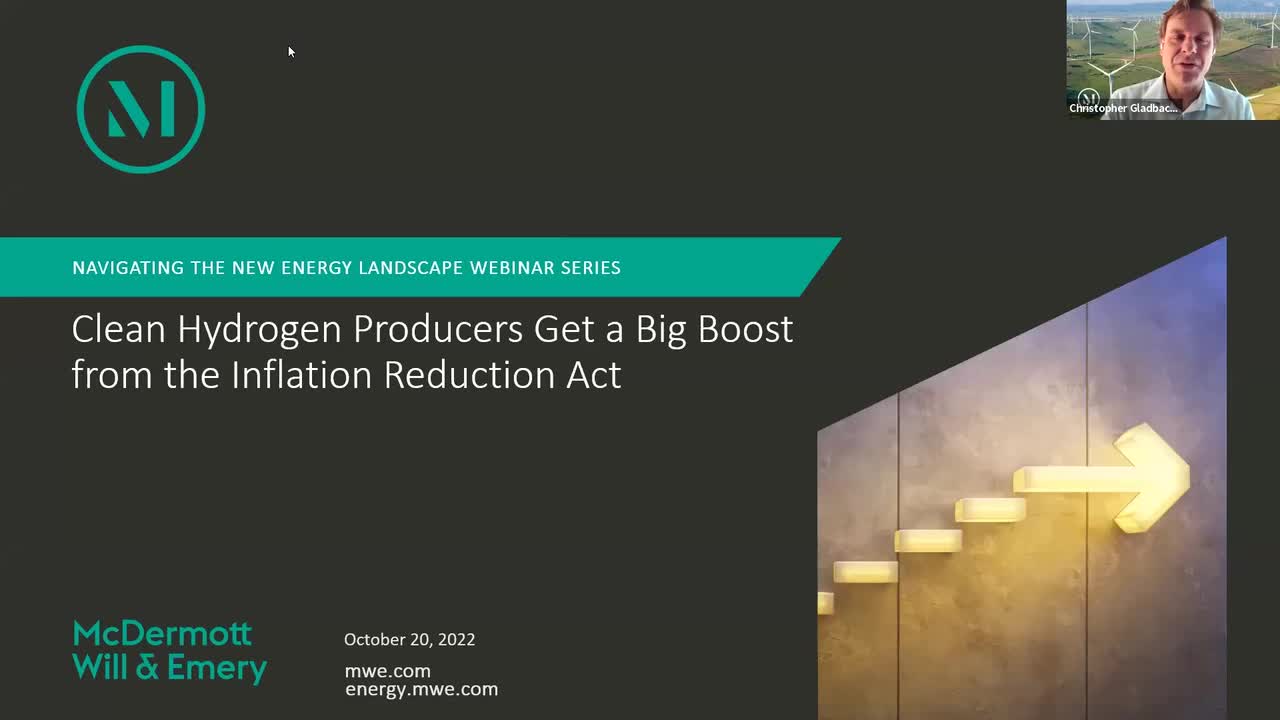Overview

Green hydrogen is a developing industry in the United States. The Inflation Reduction Act of 2022 (IRA), which includes $369 billion in energy and climate spending, even introduces a clean hydrogen production tax credit (PTC) and broadens the existing investment tax credit (ITC) to apply to hydrogen projects.
During the latest webinar in our Navigating the New Energy Landscape series, Partners Heather Cooper and Christopher Gladbach were joined by Ivana Jemelkova from FTI Consulting, Ulrich Reinhard from Air Liquide and Tommy Gerrity from Ørsted for a discussion on the future of green hydrogen development following the passage of the IRA.
Below are key takeaways from the discussion:
- The IRA introduces a new PTC for hydrogen produced after 2022 for a 10-year period from the date the project in question is placed in service. The credit is calculated as a percentage of $0.60/kg based on the resulting lifecycle greenhouse gas emissions rate and may be multiplied by five for the satisfaction of the wage and apprenticeship rules (as slightly modified compared to the standard tax credit-related wage and apprenticeship rules). To qualify for this PTC, hydrogen must be produced in the United States in the ordinary course of a trade or business for sale or use, and the production must be verified by an unrelated person.
- The IRA also introduces a new ITC equal to the energy percentage of the cost basis of each specified clean hydrogen production facility placed in service during a taxable year based on the resulting lifecycle greenhouse gas emissions rate. The credit may also be multiplied by five for the satisfaction of the wage and apprenticeship rules and is eligible to credit adders for the domestic content and energy communities’ bonuses. To be eligible for this ITC, construction of the specified clean hydrogen production facility in question must begin before 2025.
- Although the tax incentives related to hydrogen are new, the hydrogen industry has been around for over a century. Yet, it is not until recently that hydrogen production technologies have been seen as a clean energy solution. As such, there has been a visible uptick in the delivery of hydrogen through (1) renewable energy sources, such as wind and solar (referred to as green hydrogen), and (2) other energy sources, such as natural gas, supported by carbon capture and storage technology (referred to as blue hydrogen). This trend will be even further bolstered by the IRA, which strives to minimize the carbon impact over the production lifecycle of hydrogen from various energy sources and technologies.
- With the United States being the second largest consumer in the world, industry experts believe there will be no shortage of demand for hydrogen and hydrogen-related technologies in the near future, especially in light of the enactment of the IRA. Yet, despite the growing opportunities related to hydrogen (g., its use to fuel large commercial vehicles with minimal carbon emissions), there remain certain challenges in meeting this ever-growing need. Particularly, the lack of physical infrastructure, such as storage terminals and transportation pipelines, coupled with uncertainties concerning the financeability of large-scale hydrogen projects may impose certain roadblocks.
- So, what’s next? Industry stakeholders are collaborating and forming coalitions to create roadmaps for the development and success of the hydrogen market. Such strategies include co-locating hydrogen production technologies with other energy generation facilities and decarbonizing existing hydrogen production operations to capitalize on hydrogen-related tax credits and programs funded by the US Department of Energy. Likewise, it is expected that there may be an increase in bank funding and perhaps tax-equity financing as the industry continues to develop and hydrogen projects become slightly more commoditized. Regardless of the challenges presented by today’s market, it is clear the hydrogen industry is undergoing extensive transformations and growth as it continues to make its way into the clean energy space.
To access past webinars in the Navigating the New Energy Landscape series and to begin receiving Energy updates, including invitations to the webinar series, please click here.








